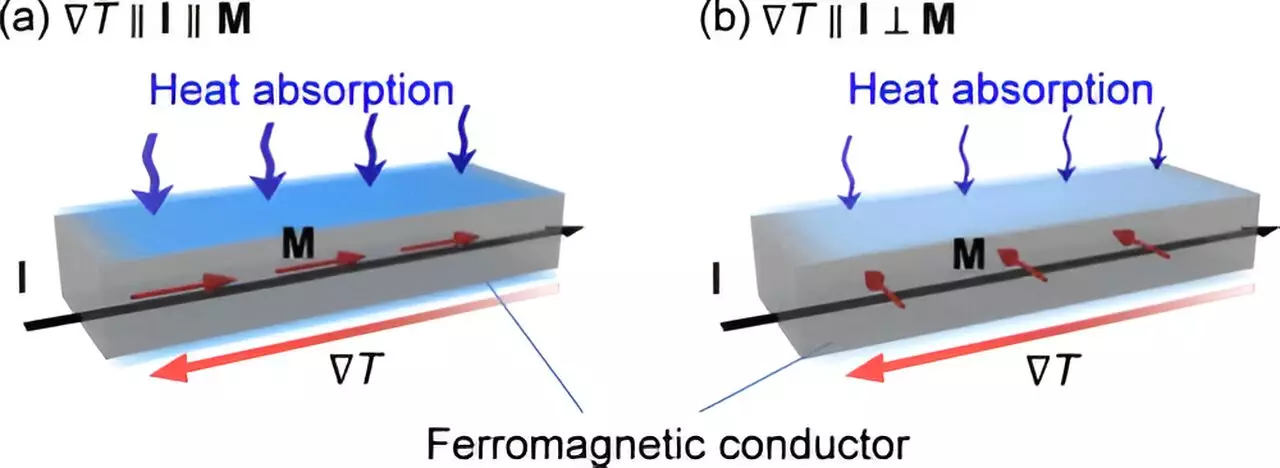In a groundbreaking study, the National Institute for Materials Science (NIMS) has accomplished the direct observation of the “anisotropic magneto-Thomson effect.” This phenomenon, which relates to the heat absorption/release proportional to an applied temperature difference and charge current, exhibits anisotropic behavior depending on the magnetization direction in magnetic materials. The implications of this research span across multiple scientific disciplines, including thermoelectrics, spintronics, and thermal management technologies. By unraveling the interplay of heat, electricity, and magnetism, this study paves the way for new insights into fundamental physics and materials science, as well as the development of innovative functionalities to control thermal energy using magnetism.
The Thomson effect has long been recognized as a fundamental thermoelectric effect in metals and semiconductors, alongside the Seebeck and Peltier effects. These effects form the basis of thermoelectric conversion technologies. However, while the influence of magnetism on the Seebeck and Peltier effects has been extensively investigated, the impact of magnetic fields and magnetism on the Thomson effect has remained elusive. This knowledge gap stems from the inherent challenges associated with measuring and quantitatively estimating the thermoelectric conversion efficiency of the Thomson effect. Despite these hurdles, NIMS made significant progress in 2020 by demonstrating the magneto-Thomson effect in nonmagnetic conductors.
Building upon their previous research, the NIMS team achieved a groundbreaking milestone by directly observing the anisotropic magneto-Thomson effect in magnetic materials through highly precise thermal measurements. By employing a thermal measurement technique known as lock-in thermography, the researchers were able to accurately measure the temperature distribution generated in a ferromagnetic alloy, Ni95Pt5, when a charge current was applied in the presence of a temperature difference. This experimental setup enabled the investigation of how the Thomson effect varies with different magnetization directions.
The findings shed light on the behavior of the anisotropic magneto-Thomson effect in magnetic materials, distinct from its conventional counterpart in nonmagnetic materials. Notably, this marked the first direct observation of this unexplored phenomenon. Upon analysis, the research team discovered that the heat absorption or release in the Ni95Pt5 alloy was greater when the temperature gradient and charge current aligned parallel to the magnetization direction compared to when they were perpendicular to it. These results align with the expectations derived from measurements of the Seebeck and Peltier effects in magnetic materials.
The research carried out by NIMS has not only uncovered the fundamental properties of the anisotropic magneto-Thomson effect but has also established quantitative measurement techniques for further exploration. Moving forward, the team will continue their investigations into the physics, materials, and functionalities of this unique effect. By exploring the intricate interplay between heat, electricity, and magnetism, the researchers aim to unearth new physics phenomena and develop applications for thermal management technologies. These advancements hold the potential to enhance efficiency and energy conservation in electronic devices.
The NIMS study on the anisotropic magneto-Thomson effect opens up new avenues for research in the fusion area of thermoelectrics and spintronics. By directly observing and analyzing the behavior of heat absorption/release in magnetic materials, the researchers have pushed the boundaries of our understanding of thermoelectric phenomena. The implications of this work extend beyond scientific curiosity, as they pave the way for the development of innovative thermal management technologies. As NIMS continues to delve deeper into the physics and applications of the anisotropic magneto-Thomson effect, exciting discoveries and practical advancements in the field of energy conversion and conservation can be anticipated.
This groundbreaking endeavor was made possible by the contributions of Rajkumar Modak, Takamasa Hirai, Seiji Mitani, and Ken-ichi Uchida, who collectively explore the intricate relationship between heat, electricity, and magnetism for the benefit of scientific progress and technological advancements.


Leave a Reply